It’s Better in the Bahamas – Part 3
A Piping Plover Adventure
By Todd Pover, Beach Nesting Bird Project Manager
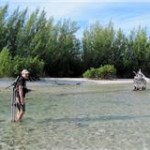
In earlier installments of this series (It’s Better in the Bahamas – Part 1 & 2), I reported on the results of the winter segment of the 2011 International Piping Plover Census in the Bahamas, in which I participated, and also the partnerships developed along the way. For this final installment I am foregoing the biological results and conservation lessons, the usual story themes, because sometimes our readers just want to hear about the adventurous side of what we do here at the Conserve Wildlife Foundation of New Jersey.
Having surveyed piping plovers on their breeding grounds in New Jersey for 15 years now, at times it feels like I know every nook and cranny that plovers could possibly be found in our state – to some extent the sense of mystery is gone. I knew that wouldn’t be the case with the Bahamas winter survey. I had never been to Abaco, the island I was assigned to survey along with Massachusetts Audubon Society’s Coastal Waterbird Program, but I knew it had miles of coastline on its main island and numerous offshore barrier islands and cays that needed to be checked as well. Our pre-trip research of the habitat on the islands suggested it was going to be difficult to cover all that ground in one week even with our 4-6 person survey team, but I was excited by the challenge.
 Be careful what you wish for. As my six-seat hopper plane from Florida made its low approach towards Marsh Harbor in Abaco, my reaction was something a little spicier than “Holy Mole”. Sand flats and beaches stretched as far as the eye could see, some in places I couldn’t begin to imagine how we were going to get to. And on top of that, we had already heard stories that we should expect plovers in unexpected places. Plovers use a fairly narrow range of habitat on the breeding grounds – and in the Bahamas we did find them on sand beaches very similar to those in New Jersey, but they were also found on limestone outcroppings, beneath massive roots in the mangroves, and even on a rock retaining wall. This added a whole new complexity – areas we had hoped to rule out as habitat to survey were now in play.
Be careful what you wish for. As my six-seat hopper plane from Florida made its low approach towards Marsh Harbor in Abaco, my reaction was something a little spicier than “Holy Mole”. Sand flats and beaches stretched as far as the eye could see, some in places I couldn’t begin to imagine how we were going to get to. And on top of that, we had already heard stories that we should expect plovers in unexpected places. Plovers use a fairly narrow range of habitat on the breeding grounds – and in the Bahamas we did find them on sand beaches very similar to those in New Jersey, but they were also found on limestone outcroppings, beneath massive roots in the mangroves, and even on a rock retaining wall. This added a whole new complexity – areas we had hoped to rule out as habitat to survey were now in play.
The truth is, in the end we couldn’t possibly survey all of the habitat that existed, suitable or not. But it was also true that very little – actually only one known location on Green Turtle Cay – was covered on Abaco (and its associated islands) on previous surveys. In the end, we managed to cover most of the island(s). There was no mother lode of piping plovers on Abaco, it was more the case of a few here and a few there, but we still found more than previously documented and we scouted and assessed dozens of locations for future surveys.
…Not your normal survey – getting around the Bahamas for the Piping plover survey any way possible!

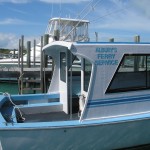
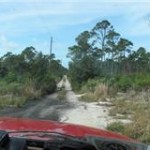

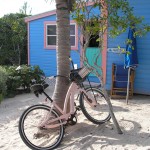
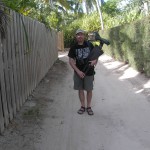
As to be expected, the hardest part of the survey was simply getting to the potential sites (and planning how to do it). Aside from the island’s main road, there were few direct routes to certain isolated beaches and surely no smooth way. In the southern half of Abaco, where much of the better plover habitat existed, there were mostly dirt side roads, often pitted, and just as often dead end roads to nowhere. And of course, the out islands and flats were only accessible by boat. This was either a transportation nightmare or fantasy, depending on your perspective. I personally used several ferry boats, a bone fishing guide’s boat, a snorkeling outfitter’s boat, a rental boat, cars, trucks, a golf cart, and (my favorite) a bright pink bicycle (on Great Guana Cay) to get around. And, of course, that’s not counting several plane rides to get there in the first place. But mostly we walked and WALKED. We waded across mangrove inlets, scurried over limestone outcroppings, and zigged and zagged over long stretches of pristine soft white sand. All that ground to cover was both exhilarating and frustrating at the same time.
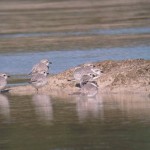
Aside from transportation logistics, there was the unknown factor of which beaches would likely yield plovers and when was the best time to survey. For the most part, aside from some indispensable tips from local birders, we just had to get out there and see things for ourselves. But still there were questions, most notably, whether to survey at high or low tide? In the end, there was just too much ground to cover in a short period of time to be picky – these were mostly all-day surveying affairs, sometimes starting before dawn and not ending until the last light slipped away, so our surveys (for better or worse) covered both tide cycles. The worst case scenario was that we recorded piping plover tracks on beaches where actual birds weren’t visually observed so we’d know to revisit those sites again on future surveys, perhaps on a different tide.
Even with all the uncertainty that comes with doing something for the first time, in the end it looks like we did something right. As I write this, Ellen Jedrey (my colleague at Massachusetts Audubon Society, who headed up the effort on Abaco last winter) and I have been invited back this winter to run a “plover” field trip and share what we learned from the survey, as part of the Abaco Science Alliance Conference, sponsored by Friends of the Environment, a local Abaco conservation group we partnered with when we where there. This is exciting to say the least and an important part of the process to help build local buy-in for conservation of piping plovers in the Bahamas, which we now know is a significant wintering site.
Discover more from Conserve Wildlife Foundation of NJ
Subscribe to get the latest posts sent to your email.